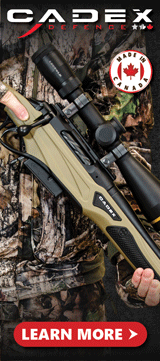You are using an out of date browser. It may not display this or other websites correctly.
You should upgrade or use an alternative browser.
You should upgrade or use an alternative browser.
30 cal bullet test, cow femurs and lots of newspaper Part 1 Part 2 Part 3 Part4 added
- Thread starter kman300
- Start date
sharp shooter
CGN frequent flyer
- Location
- Essex county (Ontario)
just a question here guys. I see that some of the bullets tested didn't have too much weight retention but still expanded well with a great deal of penetration. Is it safe to say that in these cases the weight retention isn't as important?
Sask_Hunter
CGN frequent flyer
- Location
- Saskatchewan
Thanks again kman for taking the time to do this kind of test and document the results.
Yup thanks kman really enjoy reading these tests! That 243 100gr partition would be interesting one, but I'm hesitant to say that because I already fear you've lost your life completing the tests done already. That is an immense amount of work, and I think I speak for us all in saying we all appreciate it!!
Beretta-Skeet
CGN frequent flyer
- Location
- Eastern ONT
Love all the work you put into this. Great info.
Ok, that 44 penetrated 22" with cast? That's awesome!! Great weight retention too!
Yes that ranch dog 265 is great,I shot a black bear at about 12' went in the front shoulder and found it under the skin on the opposite butt. It broke bones in the shoulder and hip,weight retention 202gr diameter .67! About 4' of penetration!
Last edited:
- Location
- Somewhere on the Hudson Bay Coast
Nice work! The Partition bulge comes as no surprise considering the forces at work, and without the partition you'd have seen lead extrusion at the base. Your test supports Dogleg's praise of the "other" North American partitioned bullet, the Swift A Frame, which has to work similarly. I like bullets that penetrate, and the performance of the mono-metals and the WFN cast stand out for me, first because I use both, and secondly because they achieve the same thing in such different ways.
The surprise for me was the .375/250 TTSX. The heavier TSX bullets in .375 in my experience penetrate much deeper, as is suppoprted with your inclusion of the .375/270 gr TSX. So I'd have expected more from the 250 gr, since the higher impact velocity should have blown the petals off sooner than would be the case with the heavier bullets, and the remaining shank with its higher remaining velocity I'd have thought would have been unstoppable. For all the talk about SD being irrelevant since the advent of mono-metal bullets, I suppose this proves otherwise.
The surprise for me was the .375/250 TTSX. The heavier TSX bullets in .375 in my experience penetrate much deeper, as is suppoprted with your inclusion of the .375/270 gr TSX. So I'd have expected more from the 250 gr, since the higher impact velocity should have blown the petals off sooner than would be the case with the heavier bullets, and the remaining shank with its higher remaining velocity I'd have thought would have been unstoppable. For all the talk about SD being irrelevant since the advent of mono-metal bullets, I suppose this proves otherwise.
Iron Sighted
CGN frequent flyer
- Location
- Peace Region
This is an excellent thread, thanks K-Man for investing the (considerable)time and effort in to conducting these tests.
Northman999
CGN Ultra frequent flyer
- Location
- Southern Yukon
Thanks for all the work and the great data.
And I can't help but think that some melted down scrap wheelweights are the winner!!!
22" penetration and .701" diameter at a cost of maybe 12 cents with the gas check...doesn't encourage me to spend ten times that much on fancy monometals unless I'm hunting grizzly with a .243.
And I can't help but think that some melted down scrap wheelweights are the winner!!!
22" penetration and .701" diameter at a cost of maybe 12 cents with the gas check...doesn't encourage me to spend ten times that much on fancy monometals unless I'm hunting grizzly with a .243.
Thanks for all the work and the great data.
And I can't help but think that some melted down scrap wheelweights are the winner!!!
22" penetration and .701" diameter at a cost of maybe 12 cents with the gas check...doesn't encourage me to spend ten times that much on fancy monometals unless I'm hunting grizzly with a .243.
The expansion to .701" is not a lot though, relative to the bullet size considering its a 44mag. Thats only like 160% the original size. Still plenty, but its not the same as something like a .600+ 30cal expanding to twice the size or more, and some of those were hitting .75 (250%) and bigger.
Also, it seems slower impact velocities give better penetration. I've read about the 45-70 with 540-grain hardcast loads penetrating deeper than the same load shot faster in a 458 Win mag.
Furthermore, penetration is only one factor of killing power. There is also the whole hydrostatic shock theory, which 1700fps is right near the minimum threshhold for that I do believe, or even slightly below it.
Last, the poor penetration for the Berger should be expected, as they are designed to bore in a few inches then violently explode to drop animals on the spot.
Very nice testing OP, and while I dont shoot a 30cal I'll definitely be thinking about this when I start reloading for my 270. (sks and enfield dont count cause I can't use 308cal bullets if I wanted to...)






































































